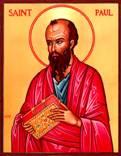Romans: Doing Good
ROMANS 7:19
 Scripture verse: “For the good that I will to do, I do not do; but the evil I will not to do, that I practice.”
Scripture verse: “For the good that I will to do, I do not do; but the evil I will not to do, that I practice.”
Objectives:
- Students should memorize the verse and understand its meaning and context.
- Students should understand what a saint is and the work that entails.
Background on the book:
The letter to the Romans was written by the Apostle Paul around AD 55-57 while he was in Corinth on his 3rd missionary journey. Since there was no public post office in the Roman Empire, Paul used the upcoming visit of a Christian in Corinth, Phoebe, to Rome by ship to send his letter. He addressed his letter to all believers, both Jews and Gentiles, living in Rome. Paul had not yet visited Rome, but he wanted to share a detailed explanation of the Gospel message. He hoped to visit Rome after he went to Jerusalem; in fact, he did visit Rome but not in the way he had planned. (How?) Find Rome, Corinth, and trace Paul’s 3rd missionary journey on a map.
Possible Lesson Plan:
- Open with prayer. The Lord’s prayer would be particularly appropriate. Can each student recite it?
- Review the background on the book. Who wrote it? To whom? Why? Find Rome on the map.
- Scripture Lesson: Read Romans 7:15-25. Read this “round robin” if you have good readers. Then have each student find and read a related verse: Romans 8:26-28, Matthew 26:31-36, 69-75, Matthew 21:28-32. Can you think of some Old Testament characters who also said they would do something and did not follow through? (Jonah would be a good example.) In the reading from Matthew, how did Peter fail to keep his promise? Why did he fail? How did he feel? What was God’s response? Work also on memorizing the verse. Lots of little words here -- perhaps a speed drill having the verse printed and cut into phrases and see how fast the students can put them together correctly.
- Group activity: Have everyone stand up with both feet on the floor. Each time they answer “yes” to one of the following questions, they must lift a foot. Is anyone standing at the end?
Have you ever said you would get up right away, then slept another 10 minutes?
Have you ever broken a New Year’s resolution?
Have you ever gotten home later than you promised?
Have you ever promised to study, then watched TV or read a book?
Have you ever told your parents you would clean your room, and not done it?
Have you ever told someone you forgave them, but stayed angry?
Have you ever promised a friend that you would keep a secret, then told it?
Why might you do these things? How do you feel when others do not do what they say they will do? (sad, betrayed, angry, etc.) How do you think others feel when you fail to keep your word?
- Icon activity: Before class, take some small, cheap icons of the saints (We’ve got lots of bulletin covers in the file cabinet.), cover them with clear plastic (e.g. contact paper), and then smear them with mud until you can’t see who they are. Let the mud dry and bring them to class. Tell the students that this is an icon. What’s wrong with it? What is a saint? What does the mud represent? (sin) How can we reveal the image of the saint? Begin to scratch off the mud, bit by bit. Is it easy to see the real saint? Are we called to be saints? Can we do this by ourselves? (See Romans 8: 18-19, 26) What are some ways we can help the Holy Spirit to work in us this miracle of sainthood? (Brainstorm here: prayer and more prayer, loving each other even in our muddied condition, sacrificing our own pleasure for another’s, etc.) Have the students take home their icon, scratch off the mud, and research the life of the saints they see. How did this saint put off sin and put on holiness?
6. Close with prayer.